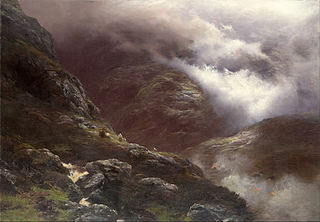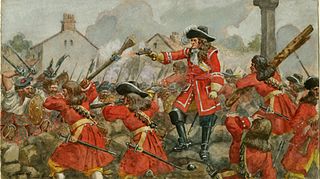
The Highlands is a historical region of Scotland. Culturally, the Highlands and the Lowlands diverged from the Late Middle Ages into the modern period, when Lowland Scots replaced Scottish Gaelic throughout most of the Lowlands. The term is also used for the area north and west of the Highland Boundary Fault, although the exact boundaries are not clearly defined, particularly to the east. The Great Glen divides the Grampian Mountains to the southeast from the Northwest Highlands. The Scottish Gaelic name of A' Ghàidhealtachd literally means "the place of the Gaels" and traditionally, from a Gaelic-speaking point of view, includes both the Western Isles and the Highlands.

The Massacre of Glencoe took place in Glen Coe in the Highlands of Scotland on 13 February 1692. An estimated 30 members and associates of Clan MacDonald of Glencoe were killed by Scottish government forces, allegedly for failing to pledge allegiance to the new monarchs, William III and Mary II.

The Kingdom of the Isles was a Norse-Gaelic kingdom comprising the Isle of Man, the Hebrides and the islands of the Clyde from the 9th to the 13th centuries AD. The islands were known to the Norsemen as the Suðreyjar[ˈsuðz̠ˌœyjɑz̠], or "Southern Isles" as distinct from the Norðreyjar[ˈnorðz̠ˌœyjɑz̠] or Northern Isles of Orkney and Shetland. In Scottish Gaelic, the kingdom is known as Rìoghachd nan Eilean. The territory is sometimes called the Kingdom of Mann and the Isles, although only some of the later rulers claimed that title. The historical record is incomplete, and the kingdom was not a continuous entity throughout the entire period. At times the rulers were independent of external control, although for much of the period they had overlords in Norway, Ireland, England, Scotland or Orkney. At times there also appear to have been competing claims for all or parts of the territory. The islands have a total land area of over 8,300 square kilometres (3,205 sq mi) and extend for more than 500 kilometres (310 mi) from north to south.

A Scottish clan is a kinship group among the Scottish people. Clans give a sense of shared identity and descent to members, and in modern times have an official structure recognised by the Court of the Lord Lyon, which regulates Scottish heraldry and coats of arms. Most clans have their own tartan patterns, usually dating from the 19th century, which members may incorporate into kilts or other clothing.

Tartan is a patterned cloth consisting of criss-crossed, horizontal and vertical bands in multiple colours, forming simple or complex rectangular patterns. Tartans originated in woven wool, but now they are made in other materials. Tartan is particularly associated with Scotland, as Scottish kilts almost always have tartan patterns. The earliest surviving samples of tartan-style cloth are around 3,000 years old and were discovered in Xinjiang, China.

Border reivers were raiders along the Anglo-Scottish border from the late 13th century to the beginning of the 17th century. They included both Scottish and English people, and they raided the entire border country without regard to their victims' nationality. Their heyday was in the last hundred years of their existence, during the time of the House of Stuart in the Kingdom of Scotland and the House of Tudor in the Kingdom of England.

Lord of the Isles or King of the Isles (Scottish Gaelic: Triath nan Eilean or Rìgh Innse Gall) is a title of Scottish nobility with historical roots that go back beyond the Kingdom of Scotland. It began with Somerled in the 12th century and thereafter the title was held by a series of his descendants, the Norse-Gaelic rulers of the Isle of Man and Argyll and the islands of Scotland in the Middle Ages. They wielded sea-power with fleets of galleys (birlinns). Although they were, at times, nominal vassals of the kings of Norway, Ireland, or Scotland, the island chiefs remained functionally independent for many centuries. Their territory included much of Argyll, the Isles of Arran, Bute, Islay, the Isle of Man, Hebrides, Knoydart, Ardnamurchan, and the Kintyre peninsula. At their height they were the greatest landowners and most powerful lords after the kings of England and Scotland.

A henchman is a loyal employee, supporter, or aide to some powerful figure engaged in nefarious or criminal enterprises. Henchmen are typically relatively unimportant in the organization: minions whose value lies primarily in their unquestioning loyalty to their leader. The term henchman is often used derisively, or even comically, to refer to individuals of low status who lack any moral compass of their own.
A dirk is a long bladed thrusting dagger. Historically, it gained its name from the Highland Dirk where it was a personal weapon of officers engaged in naval hand-to-hand combat during the Age of Sail as well as the personal sidearm of Highlanders. It was also the traditional sidearm of the Highland Clansman and later used by the officers, pipers, and drummers of Scottish Highland regiments around 1725 to 1800 and by Japanese naval officers.

George IV's visit to Scotland in 1822 was the first visit of a reigning monarch to Scotland in nearly two centuries, the last being by Charles II for his Scottish coronation in 1651. Government ministers had pressed the King to bring forward a proposed visit to Scotland, to divert him from diplomatic intrigue at the Congress of Verona.

Tartanry is the stereotypical or kitsch representation of traditional Scottish culture, particularly by the emergent Scottish tourism industry in the 18th and 19th centuries, and later by the American film industry. The earliest use of the word "tartanry" itself has been traced to 1973. The phenomenon was explored in Scotch Myths, a culturally influential exhibition devised by Barbara and Murray Grigor and Peter Rush, mounted at the Crawford Centre at the University of St Andrews in the Spring of 1981. Related terms are tartanitis, tartan-tat, Highlandism, Balmorality, and Sir Walter Scottishness.
A Duine Uasal or duin' uasal, anglicised as Dunnie-wassal etc. by Walter Scott et al., was a Highland gentleman or noble. This word generally misprinted in the Lowlands, and by Scott in his excellent ballad of Bonnie Dundee, is from the Scottish Gaelic duine meaning a "man", and "uasal" meaning "gentle, noble, or of good birth". Uasal (Wassal) is not cognate with the English language term "vassal". It is sometimes written "duin' uasal". It is the same in the Irish language, Gaeilge.

Clan Buchanan is a Highlands Scottish Clan whose origins are said to lie in the 1225 grant of lands on the eastern shore of Loch Lomond to clergyman Sir Absalon of Buchanan by the Earl of Lennox.

The Battle of Mulroy was a Scottish clan battle fought in August 1688 in the Lochaber district of Scotland. It was fought between the Clan Mackintosh who were supported by government troops under Kenneth Mackenzie of Suddie against the Clan MacDonald of Keppoch who were supported by the Clan Cameron over disputed lands in the Braes of Lochaber. The battlefield has been inventoried and protected by Historic Scotland under the Scottish Historical Environment Policy of 2009.

The Dunvegan Cup is a wooden ceremonial cup, decorated with silver plates, which dates to 1493. It was created at the request of Caitríona, wife of John Maguire, lord of Fermanagh. The cup is an heirloom of the Macleods of Dunvegan, and is held at their seat of Dunvegan Castle.

The Lady of the Lake is a narrative poem by Sir Walter Scott, first published in 1810. Set in the Trossachs region of Scotland, it is composed of six cantos, each of which concerns the action of a single day. There are voluminous antiquarian notes. The poem has three main plots: the contest among three men, Roderick Dhu, James Fitz-James, and Malcolm Graeme, to win the love of Ellen Douglas; the feud and reconciliation of King James V of Scotland and James Douglas; and a war between the Lowland Scots and the Highland clans. The poem was tremendously influential in the nineteenth century, and inspired the Highland Revival.
Manrent refers to a Scottish contract of the mid-15th century to the early 17th century, usually military in nature and involving Scottish clans. The bond of manrent was commonly an instrument in which a weaker man or clan pledged to serve, in return for protection, a stronger lord or clan—in effect becoming a vassal that renders service to a superior, often made in the form of a covenant. Manrents were a Promise by one person to serve another, [such] that he shall be friend to all his friends, and foe to all his foes.
There is some evidence on historical fencing as practised in Scotland in the Early Modern Era, especially fencing with the Scottish basket-hilted broadsword during the 17th to 18th centuries.
The water bull, also known as tarbh-uisge in Scottish Gaelic, is a mythological Scottish creature similar to the Manx tarroo ushtey. Generally regarded as a nocturnal resident of moorland lochs, it is usually more amiable than its equine counterpart the water horse, but has similar amphibious and shapeshifting abilities.















